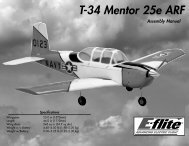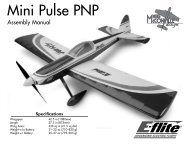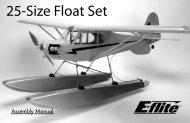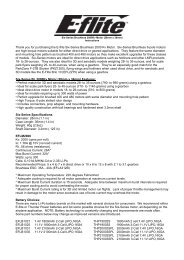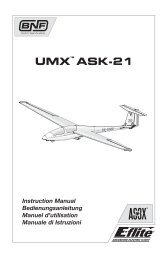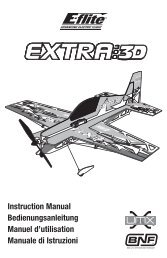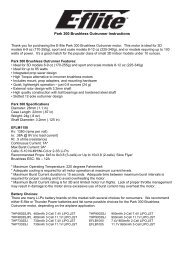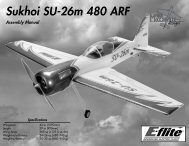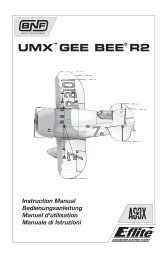Ascent 450 BL Park Glider PNP - E-flite
Ascent 450 BL Park Glider PNP - E-flite
Ascent 450 BL Park Glider PNP - E-flite
Create successful ePaper yourself
Turn your PDF publications into a flip-book with our unique Google optimized e-Paper software.
Glide Testing Your <strong>Ascent</strong> <strong>PNP</strong><br />
We strongly recommend that before you fly your new <strong>Ascent</strong>,<br />
you first perform a test glide. Pick a flat spot that has soft, tall<br />
grass and is free from obstructions. You first want to check out the<br />
<strong>Ascent</strong>’s performance but also check your performance as a pilot.<br />
It also allows you to make corrections to any building or control<br />
defects that may have been overlooked. The test glide should be<br />
done with an assistant on a calm day.<br />
<br />
<br />
<br />
<br />
Hint: A good time during the day is very early in the<br />
morning or at dusk when the wind is calm. You want to<br />
be able to concentrate on what the model is doing, and<br />
have time to think about what you're doing. We will<br />
assume you have an assistant during the following steps.<br />
1. Range check your radio system and check the control<br />
throws. Make sure the control surfaces move in the<br />
proper direction.<br />
2. Have the assistant hold the <strong>Ascent</strong> under the wing<br />
near the CG and run forward until they can sense the<br />
wing developing lift. Don't release the glider yet. See if<br />
the model wants to lift. If not, add a bit of up elevator<br />
trim and try again.<br />
3. This step may take some practice on the part of your<br />
assistant. What you want them to do now is run forward,<br />
but a bit faster, with the nose of the plane pointed at the<br />
horizon with the wings level (not nose down or nose up).<br />
Then thrust the <strong>Ascent</strong> forward in a line straight toward<br />
the horizon and release it.<br />
4. When the assistant releases the model, watch it<br />
carefully. A properly trimmed aircraft will fly straight,<br />
gliding to a smooth landing about 50 feet away. If the<br />
<strong>Ascent</strong> pitches nose down, the CG is too far back and<br />
you have a nose-heavy condition. Remove some weight<br />
from the nose. If the <strong>Ascent</strong> pitches nose up sharply, and<br />
<br />
<br />
<br />
<br />
stalls, you have a tail-heavy condition (the CG is too far<br />
forward), and you need to remove weight from the tail or<br />
move the battery and receiver further forward.<br />
5. Turns to the left or right after launch can be adjusted<br />
through the use of right or left rudder trim.<br />
Important: Make any trim adjustments in small<br />
increments. Large changes can result in abrupt turns,<br />
causing tip stalls and loss of control.<br />
6. If you have to make large trim adjustments on your<br />
transmitter, you may have other problems, such as warps.<br />
Check the wings, elevator, and rudder to make sure there<br />
are no warps in the airframe. Make sure the wings are<br />
aligned and mounted properly on the fuselage. When<br />
you have the <strong>Ascent</strong> trimmed and the CG adjusted so<br />
it glides properly in a "hands off" manner, return your<br />
transmitter trim switches to their neutral position, then<br />
make the appropriate mechanical linkage corrections to<br />
return the control surfaces to their test glide positions.<br />
7. After you have made the necessary corrections, glide<br />
test the model again to make sure it is trimmed properly<br />
with the transmitter trims in neutral.<br />
8. You are now ready to launch under power. Hold the<br />
fuselage under the wing with the model powered up.<br />
Apply half throttle and gently toss the model into the<br />
wind at a slight nose up attitude. The model will fly out<br />
strongly and you will be able to climb to altitude in a<br />
very short time. Moving the throttle stick to idle (or cutoff)<br />
you will find the prop will stop spinning and fold against<br />
the fuselage. You are now ready to hunt for thermals and<br />
enjoy the calm air.<br />
E-<strong>flite</strong> <strong>Ascent</strong> <strong>PNP</strong> Assembly Manual<br />
19



